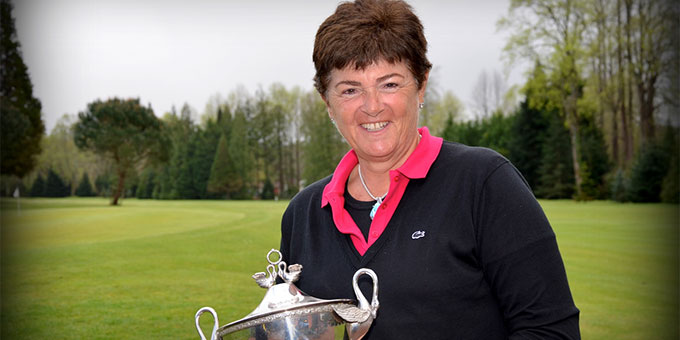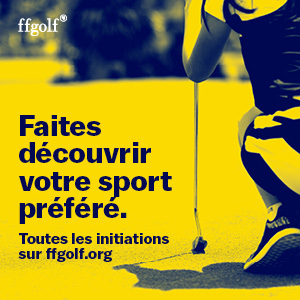Posted on July 28, 2020 in News.
Anne Marie Palli: "During my career, it was a bit all or nothing"
Anne Marie Palli is one of four French players to have won on the American circuit and has lived in Scottsdale, Arizona, for the past twenty-four years. The native of Ciboure, in the Basque Country, talks about the women's circuit and looks back on her great career. Interview.
Hello Anne Marie, you have been living in the United States for forty years and since 1996 in Arizona. What are you doing now?
At the moment not much (laughs)! I still love competition and play on the senior circuit, even though in my head I'm still 20 and this year they canceled everything because of the pandemic. I like to teach, to transmit, to see people having fun in golf. Golf is a great game, there aren't many sports like this: you can play it on your own or with friends of different skill levels, and you can play it for your entire life. Here, tomorrow I'm playing with Bill Johnston, the architect of the golf course where I won my first LPGA tournament, in 1983 in Phoenix. He is 95 years old ...
You are one of the rare French players with Catherine Lacoste, Patricia Meunier-Lebouc and Céline Boutier to have won on the American circuit. Do we still talk to you about it often?
I am even the first European professional to have won on the LPGA, because Catherine Lacoste won the US Open as an amateur. But hey, we don't really talk to me anymore. There are other players now, new generations and we are more focused on what is recent, which is quite normal.
You've won the LPGA twice, in two different ways. First in Phoenix (Arizona) in 1983 with a 7-stroke lead…
It was a dream for me to win in the United States. But the year before my first victory, in 1982, I had already won 9 tournaments on the mini Tour, the equivalent of the Symetra Tour today, and I finished in first place that season. I had a bit of the same trajectory as Perrine Delacour in fact. We both started on the American circuit, before losing our card and coming back. As the Americans say: “Winners never quit, leaving never win! " (Those who win never give up, those who give up never win). During my career, I have never been a model of consistency, it was a bit all or nothing. Quite the opposite of a player like Karine Icher for example, to whom I wish to win one day in the United States, she deserves it.
Nine years later, you win in Atlantic City (New Jersey), in the play-off against a certain Laura Davies!
Yes, something happened to me there. On the last day, I split the game with Laura Davies and on hole 18, I have a 4 meter putt to go into the play-off. At that time, I never thought about the play-off, I was only in the present moment, not in the future… and I put in the putt. It's so important to be focused in the moment in these cases, but so difficult too. Some days it's easier to do than others, we don't really know why. Tiger Woods and Annika Sörenstam had that ability. Thoughts and the body do not go at the same speed, you have to succeed in bringing them into harmony.
And then you beat Laura Davies on top of that!
She was not happy! That year, she lost twice in the play-off, against me and against Nancy Lopez. I remember she said, laughing, that it was a humiliation for her to lose to a Mexican and a French (laughs). Laura Davies, she was extraordinary. She was doing the opposite of what everyone else was doing and she was winning because she knew each other very well. I'm sure during the tournament she would stay playing in the casino until 2 a.m. (laughs). Laura, I still see her from time to time on the senior circuit.
What is your worst memory?
When it's too painful, I tend to bury it in my subconscious. You know, during my career, I was my own coach, my own shrink, my own nutritionist. I even thought I spoke English before arriving in the United States (laughs)! The adaptation was not easy at first, especially in terms of food, I came from a family of gourmets in addition ...
You had a reputation for having a big ball hit. Was that your strong point?
It is true that I typed further than the majority of players. But my strong point was rather my little game, it was something innate, I didn't need to work on it too much. My strength of character too. I read a lot of books on the mind, esotericism, philosophy and I tried to apply that to golf. My weakness was probably the irregularity of my swing, of my ball strike.
Apart from power, what do you think most differentiates the female and male circuit?
For a long time, we noticed that men putt better than women, but it tends to rebalance since we better understand the mechanisms at work in putting I think. The main difference is on the mental level. Men have more confidence in themselves. Even if they don't have the "skill", they have character. And then the professional players have to come to the United States if they want to acquire world status.
You meet every three months with Catherine Lacoste, Patricia Meunier-Lebouc and Nathalie Jeanson, to determine which players you will help financially within the framework of the Porosus * endowment fund. Is it important for you to support women's golf in France?
Of course ! Look at the best players in the world, they've often been helped. Mainly, you have to have a good technical coach and a good mental coach. Afterwards, you must also maintain good physical condition. I do not like to hear that the French do not train enough, it is wrong. I have been in the United States for over forty years and there is undoubtedly a cultural difference between the United States and France. With us, we tend to criticize, to be skeptical or negative. Americans are much more positive, they believe in it more, it's in their mentality.
As a teacher, you are a follower of "wright balance technogy". What is it about ?
The idea is to do exercises and have a swing that allows you to maintain the symmetry of your body. We take your measurements, your weight, we analyze your swing, we put that on a computer and we see what your tendency is. We then determine which posture, stance, and grip are the most suitable and balanced for you in order to be longer, straighter and better physically. I would like to make this known in France next year. Many players today, including young people, spend hours doing weight training when it only accentuates body imbalances and therefore the risk of injury. When I see Jason Day or even Tiger Woods having difficulty bending down to pick up the ball, it hurts my heart.
How did you start playing golf?
At the age of 4, with my grandfather and my father, who was a golf teacher. I then followed him to Etretat, I was 28 disabled at 9 years old. We have always lived in a golf course. At school, with my southwest accent, things were not going very well. Suddenly, my parents sent me to boarding school in Saint-Jean-de-Luz, between 8 and 12 years old. In the end, it prepared me to live alone, it was useful for my professional career afterwards.
But when you were in boarding school, could you play golf?
Yes, on the weekends ... if I wasn't glued (laughs).
Have you ever completed a hole-in-one?
I did 10, last year. My father had made an albatross, 2 on a par 5, it is even more difficult I find.
Did you do 10 holes in one? It is enormous !
You know, the 95-year-old man I'm playing with tomorrow made 25. I still have thirty years to catch up with himlaughs).
Catherine Lacoste recently told us that she had not succeeded in a single one… **
Ah yes ?! Catherine, I remember when she won the US Open in 1967, I was 12 years old. It was she who made me want to play in the United States. She showed us French women that it was doable. A bit like Ballesteros showed that you can beat the Americans, in the men.
She also confided that she would not trade her US Open for a hole in one ...
While I would swap one of my holes for one for a US Open (laughs)!
Is there a player that you admired during your career?
Joanne Carner. It's funny because I just posted a photo with her and her sister on my facebook page. I remember his first victory at the US Open, in Chicago (in 1971. ). I liked the way he played and his personality. She never made excuses for herself when she was playing badly. He was a very funny person, who always had anecdotes to tell. She turned pro at just 30 and then entered the Hall of Fame!
Your favorite course?
In France, I replayed Morfontaine a few years ago, it was fabulous. The setting, the architecture of the golf course… there is something almost metaphysical about it. I also really liked Saint-Cloud, Chantilly, la Boulie… These are old courses with a story and I appreciate them even better now than when I was young.
And in the United States?
Cypress Point in California, designed by Alistair McKenzie, the architect of Augusta. Hole 16, a par 3 210 meters above the ocean, is magical.
You haven't made a hole in one there?
No (laughs), and I was almost happy to be on the green. Wind against, you almost have to take out the driver! Initially, MacKenzie wanted to build a dogleg par 4 and it was fellow World Golf Hall of Fame member Marion Hollins who prompted him to make it a par 3 over the Pacific.
What do you think is the most common fault among amateurs?
They very often think that they are hitting the ball farther than they actually are. They take their best shot into account when choosing their club and are usually too short. And they don't train enough for the little game when statistics show that 70% of the time, we play shots from less than 100 meters.
Interview by Franck Crudo
Anne Marie Palli
* https://www.fonds-porosus.org/
** read the article in reference
Catherine Lacoste: "I often took my iron 1 out of the bag when it was windy"
Pauline Roussin-Bouchard qualified for the US Women's Open
Louise Uma Landgraf wins brilliantly at the Girls' U16 Amateur Championship
Grace Kim leads the JM Eagle LA Championship









